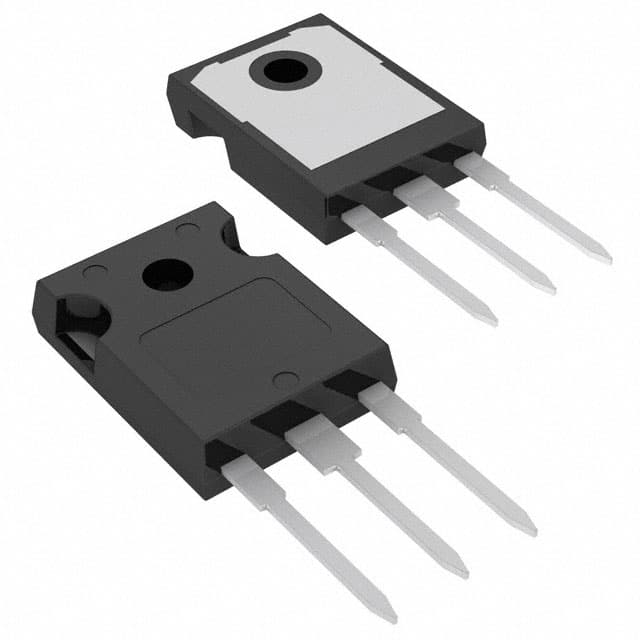Viz Specifikace pro podrobnosti o produktu.

TIP141G Transistor: Encyclopedia Entry
Introduction
The TIP141G transistor is a crucial component in electronic devices, known for its versatile applications and reliable performance. This encyclopedia entry provides an in-depth overview of the TIP141G transistor, including its product category, basic information, specifications, pin configuration, functional features, advantages and disadvantages, working principles, application field plans, and alternative models.
Product Category and Basic Information Overview
- Category: Power Transistor
- Use: Amplification and switching of electronic signals
- Characteristics: High power dissipation capability, low collector-emitter saturation voltage, and high current gain
- Package: TO-220
- Essence: NPN Darlington transistor
- Packaging/Quantity: Typically available in reels or tubes containing multiple units
Specifications
- Collector-Emitter Voltage (VCEO): 100V
- Collector-Base Voltage (VCBO): 100V
- Emitter-Base Voltage (VEBO): 5V
- Collector Current (IC): 10A
- Power Dissipation (PD): 65W
- Operating Temperature Range: -65°C to 150°C
Detailed Pin Configuration
The TIP141G transistor has a standard TO-220 package with three pins: 1. Base (B): Input terminal for controlling the transistor's operation 2. Collector (C): Terminal connected to the positive supply voltage 3. Emitter (E): Output terminal for the amplified or switched signal
Functional Features
- High current gain and power dissipation capability
- Low saturation voltage, enabling efficient switching operations
- Robust construction suitable for demanding applications
Advantages and Disadvantages
Advantages
- High power handling capacity
- Reliable amplification and switching performance
- Wide operating temperature range
Disadvantages
- Relatively larger package size compared to smaller SMD transistors
- Higher cost compared to standard bipolar junction transistors (BJTs)
Working Principles
The TIP141G operates based on the principles of bipolar junction transistors, utilizing a Darlington pair configuration to achieve high current gain and low saturation voltage. When a small input current is applied to the base terminal, it controls the larger current flow between the collector and emitter terminals, enabling amplification or switching of signals.
Detailed Application Field Plans
The TIP141G transistor finds extensive use in various electronic applications, including: - Audio amplifiers - Power supplies - Motor control circuits - Lighting systems - Switching regulators
Detailed and Complete Alternative Models
Several alternative models can be considered as substitutes for the TIP141G transistor, including: - TIP142G - TIP145G - TIP146G - MJ11015 - MJ11016
In conclusion, the TIP141G transistor stands as a reliable and versatile component in the realm of power transistors, offering high performance and broad applicability across diverse electronic systems.
Word Count: 443
Seznam 10 běžných otázek a odpovědí souvisejících s aplikací TIP141G v technických řešeních
What is TIP141G?
- TIP141G is a high power NPN transistor designed for general-purpose amplifier and switching applications.
What are the key features of TIP141G?
- The key features include high current capability, low collector-emitter saturation voltage, and complementary PNP type available (TIP146G).
What are the typical applications of TIP141G?
- Typical applications include audio amplifiers, power switches, motor control, and solenoid drivers.
What is the maximum collector current rating of TIP141G?
- The maximum collector current rating is 10A.
What is the maximum collector-emitter voltage rating of TIP141G?
- The maximum collector-emitter voltage rating is 100V.
How should TIP141G be mounted for optimal performance?
- TIP141G should be mounted on a heat sink to ensure proper heat dissipation.
What are the recommended operating conditions for TIP141G?
- The recommended operating conditions include a maximum junction temperature of 150°C and a maximum power dissipation of 65W.
Can TIP141G be used in high-frequency applications?
- TIP141G is not suitable for high-frequency applications due to its transition frequency characteristics.
What are the typical thermal resistance values for TIP141G?
- The typical thermal resistance values are 1.67°C/W (junction to case) and 62.5°C/W (junction to ambient).
Are there any specific precautions to consider when using TIP141G?
- It is important to avoid exceeding the maximum ratings and to ensure proper heat sinking to prevent overheating and potential damage to the transistor.

